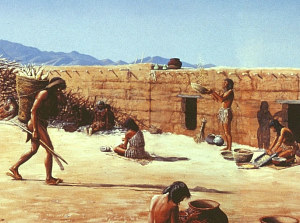Agriculture in the Trans-Pecos
Roughly 2,000-3,000 years ago during the latter part of the Archaic people began growing corn in favorable settings in the far western part of the greater Trans-Pecos region. At first agriculture must have been little more than a seasonal supplement to wild plants and animals, but successfully growing crops involves a commitment to staying in one place for extended periods of time. Thus, agriculture and sedentary life developed hand in hand. By 800-1,000 years ago agriculture was a mainstay of village life in the western Trans-Pecos and, to a lesser extent, in the vicinity of La Junta del los Rios in the Big Bend where the Rios Grande and Conchos meet. The settled peoples developed larger scale societies that interacted with one another through trade and social alliances. But much of the Trans-Pecos region seems to have remained the domain of mobile hunters and gatherers.
[Agriculture is a broad term that refers to the practice of cultivating plants. It encompasses several different kinds of cultivation including horticulture, the small scale farming of a variety of plants for consumption. Horticulture, or gardening, probably best describes the kind of cultivation practiced by the prehistoric peoples of the Trans-Pecos.]
Corn (Zea mays L.) was the most common and important cultigen in the Trans-Pecos, but beans, squash, amaranth, cotton, and tobacco were also grown. These plants had been domesticated thousands of years earlier in Mesoamerica, but it took generations of selective breeding to transform them from tropical cultigens to varieties that could survive in the arid American Southwest. Recent evidence suggests that corn had spread across northwestern Mexico and much of the American Southwest by 1,000 B.C., although in most areas it did not become a staple crop until after A.D. 500.
The first conclusive evidence for the use of cultigens in the greater Trans-Pecos region comes from Tornillo Shelter, 64 kilometers (40 miles) north of El Paso in the San Andres Mountains, and Fresnal Shelter and High Rolls Cave, 160 kilometers (100 miles) north of El Paso in the Sacramento Mountains. Corn recovered from Tornillo Shelter dates to sometime between 2030 and 830 B.C. and corn and amaranth recovered from Fresnal Shelter dates to sometime between 1370 and 940 B.C. Corn recovered from High Rolls Cave dates to sometime between 1310 and 940 B.C. and amaranth and tobacco date to 1040 B.C. These dates are fairly consistent with the estimated arrival time of corn in northern Chihuahua and southern New Mexico and Arizona sometime between 1200 and 800 B.C.
The degree of dependence on agriculture during the Late Archaic is difficult to determine, but was likely quite modest in most areas of the western Trans-Pecos. Corn is very common in the Late Archaic deposits of Fresnal Shelter, Todsen Shelter, and other Organ Mountain rockshelters, suggesting a moderate to high degree of dependence on agriculture in these particular places. Corn and other cultigens are exceedingly rare, however, in the Late Archaic components of other sites across the region, even those with well-preserved deposits.
In the Trans-Pecos, agriculture appears to have been just one facet of a broad-spectrum subsistence economy that included mesquite seeds and pods, desert succulents such as sotol and lechuguilla, berries, forbs, and various species of cacti and grasses. Burned-rock features representing earth ovens used to process (bake) desert succulents become both more numerous and much larger during the Late Archaic, indicating intensified exploitation of these resources.
The decreased mobility pattern and intensified land use practices established during the Late Archaic continued through the subsequent Formative period in the western Trans-Pecos (200–1450 A.D.) and Late Prehistoric period in the eastern Trans-Pecos (900–1500 A.D.). In the western Trans-Pecos, mobility further decreased and agricultural dependence increased, culminating in the Puebloan occupations of A.D. 1275–1450. A similar development took place at La Junta. In the rest of the eastern Trans-Pecos, however, agriculture never took root and the mobility and subsistence patterns established during the Late Archaic persisted throughout the Late Prehistoric.
Between A.D. 200 and 1150, cultigens are rare in the archeological record of the western Trans-Pecos, even in the rockshelters that had large quantities of corn in the Late Archaic, but the prevalence of mesquite, desert succulents, and cacti in the archeological record steadily increased, as well as the number of burned rock features used to process them. At Ojasen and Gobernadora, for example, thousands of charred plant remains were identified in flotation samples from burned-rock features, but only a handful of them were identified as cultigens.
Between A.D. 1150 and 1275, the prevalence of corn and beans in the archeological record increased dramatically, while the prevalence of desert succulents and cacti continued to steadily increase, and the prevalence of mesquite abruptly decreased. The increased dependence on agriculture by the people of the western Trans-Pecos is accompanied by the appearance of villages of formally constructed houses and an increased emphasis on food storage. There is also a sharp increase in the frequency and size of burned-rock features, indicating an increased reliance on bulk processing of desert succulents. The Formative component of Keystone Dam alone has 190 burned rock features. The reason for this simultaneous increase in dependence on agriculture and desert succulent processing is not well understood, but it may have been a way to buffer against low crop productivity or even failure.
After A.D. 1275, the people of the western Trans-Pecos had become agriculturally specialized. They now resided in multi-room pueblos near their fields for much of the year and relied heavily on agriculture for their subsistence needs. Corn is an exceedingly common component of the subsistence remains recovered from such pueblos as Hot Well Pueblo and Firecracker Pueblo. Though wild plants continued to be exploited by the people of the western Trans-Pecos, the evidence for intensive desert succulent processing during this period drops off considerably, suggesting that agricultural specialization had replaced the need for the intensive exploitation of these resources.
Despite an awareness of the changes taking place in the western Trans-Pecos during the Formative, the Late Prehistoric people of the eastern Trans-Pecos maintained the mobility and subsistence patterns that they had established during the Late Archaic. They continued to live in quickly built brush structures (wickiups) and moved their camps seasonally or more frequently as food availability dictated. Only a handful of Late Prehistoric sites in the eastern Trans-Pecos have yielded evidence of cultigens.
Carved Rock Shelter has produced corn, Bee Cave Canyon has produced corn, squash, and amaranth, and Granado Cave has produced cotton, but it is not clear whether these cultigens were being grown near the sites, or obtained through trade from the western Trans-Pecos or northern Chihuahua. Burned rock middens and mortar holes are common in Late Prehistoric sites, such as Squawteat Peak and Wind Canyon, indicating a continued reliance on desert succulent and mesquite bean processing. Despite the presence of cultigens in the eastern Trans-Pecos, the evidence of Late Prehistoric subsistence practices from the region indicates a continuation of the broad-spectrum subsistence economy established during the Late Archaic.
The exception to this pattern in the eastern Trans-Pecos is the La Junta district, where small pithouse villages developed around A.D. 1200. The people who resided in these villages grew corn, beans, and squash, but continued to rely heavily on wild plants. They never became as agriculturally specialized as the people of the western Trans-Pecos, and only grew cultigens in years that the Rio Grande flooded enough to adequately water their fields.
Around A.D. 1450 the pueblos of the western Trans-Pecos were abandoned and the region was depopulated. Though it is unclear exactly why this occurred, it is possible that the agricultural economy of the western Trans-Pecos had become too specialized and was crippled by an extended period of drought, leading to wide-spread subsistence failure. The people who remained in the region between A.D. 1450 and 1680 reverted to a less intensive mobile adaptation that had closer affinities with the adaptations of the Middle Archaic period than with those of the Late Archaic and Formative periods. Dona Ana County Airport is the only known archeological site in the region that dates to this time period.
Agriculture was not practiced again in the western Trans-Pecos until the Spanish established the Missions of El Paso in the late 17th century. The native people of El Paso, along with the people who had been brought to the missions from the pueblos of New Mexico, once again cultivated their native crops of corn, beans, and squash, but they now began to grow wheat and fruits that had been brought to the New World by the Spanish. They also continued to rely to differing degrees on mesquite and cacti.
Unlike the pueblos of the western Trans-Pecos, the villages of La Junta were not abandoned after 1450 A.D. The people of La Junta continued to cultivate native crops throughout the Spanish Colonial period, but added Spanish crops, such as wheat, watermelon, and cantaloupes to their fields. Today, La Junta (vicinity of present-day Presidio, Texas and Ojinaga, Mexico) bears the distinction of having some of the longest continuously cultivated tracts of land in all of the present-day United States.
In summary, although cultigens first appeared in the western part of the Trans-Pecos around 1000 B.C., agriculture spread slowly and unevenly across the region. Throughout the Late Archaic and most of the Formative/Late Prehistoric, agriculture was only practiced in the far western Trans-Pecos and made up only a small part of a broad-spectrum subsistence economy that relied heavily on wild plants. After A.D. 1150, agriculture dramatically increased in economic importance in the western Trans-Pecos and made its first appearance in the La Junta area of the eastern Trans-Pecos. By A.D. 1275, the people of the western Trans-Pecos had become agricultural specialists, while for the people of La Junta farming was a part-time activity, and those in the rest of the eastern Trans-Pecos grew crops rarely if at all. In A.D. 1450, the overspecialized agricultural economy of the western Trans-Pecos collapsed, but agriculture continued to play a seasonal role at La Junta. The Spanish brought their own cultigens to the western Trans-Pecos and La Junta in the following centuries, where they were grown alongside native cultigens.
Contributed by Carly Whelan and Heather Smith.
Sources:
Kenmotsu, Nancy A.
1994 Helping Each Other Out, A Study of the Mutualistic Relations of Small Scale Foragers and Cultivators in La Junta de los Rios Region, Texas and Mexico. Unpublished Ph.D. dissertation, Department of Anthropology, University of Texas, Austin.
Lentz, Stephen C.
2006 High Rolls Cave: Insectos, Burritos, y Frajos, Archaic Subsistence in Southern New Mexico. Archaeology Notes 345, Museum of New Mexico Office of Archaeological Studies; Techical Series 2005-1, New Mexico Department of Transportation, Santa Fe.
Miller, Myles R. and Nancy A. Kenmotsu
2004 Prehistory of the Jornada Mogollon and Eastern Trans-Pecos Regions of West Texas. In: The Prehistory of Texas, edited by Timothy K. Perttula, pp. 205-265. Texas A&M University Press, College Station.
Hard, Robert J. and J.R. Roney
2005 The Transition to Farming on the Río Casas Grandes and in the Southern Jornada Mogollon. In The Late Archaic Across the Borderlands: From Foraging to Farming, edited by B.J. Vierra, pp. 141-186. The University of Texas Press, Austin.
Tagg, Martyn D.
1996 Early Cultigens from Fresnal Shelter, Southeastern New Mexico. American Antiquity 61(2):311-324.
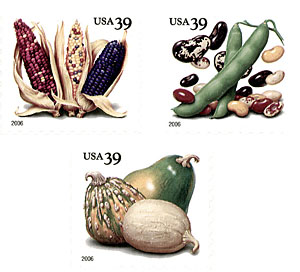
|
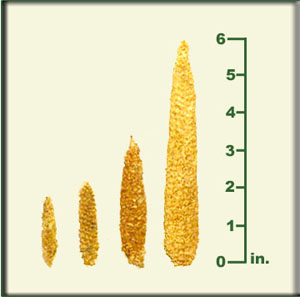
The evolution of corn or maize (Zea mays) involved the gradual increase in the size of the grain head (ear) shown here, as well as the development of varieties that would tolerate the prevailing climatic conditions in different areas of the New World. |
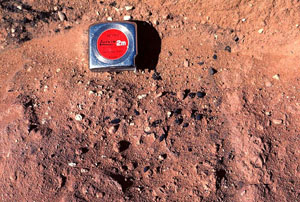
|
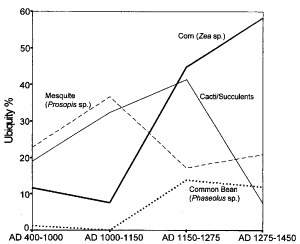
|
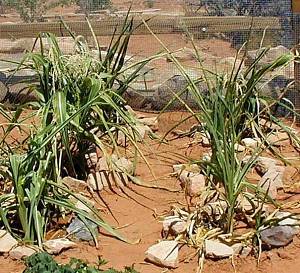
|
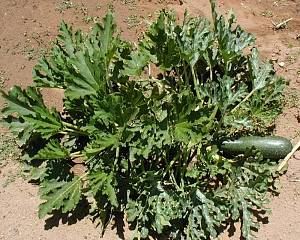
|
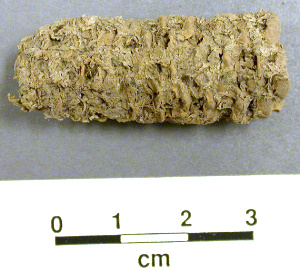
|
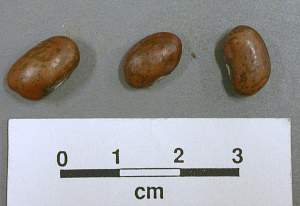
|
